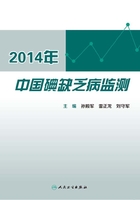
上QQ阅读APP看书,第一时间看更新
各省、市、自治区碘缺乏病监测
2014年北京市碘缺乏病病情调查报告
■ 李阳桦 任海林 王全意 刘博 黎新宇
(北京市疾病预防控制中心)
摘要
目的 全面了解北京市碘缺乏病病情变化趋势及重点人群碘营养水平。
方法 采用人口比例抽样方法确定调查对象;B超法检测8~10岁学生甲状腺大小;尿中碘的砷铈催化分光光度测定法及其改良方法测定尿碘;直接滴定法(GB/T 13025.7—1999)测定盐碘含量。
结果 8~10岁学生甲状腺肿大率0.92%;学生尿碘中位数177.0μg/L,孕妇尿碘中位数为148.2μg/L;学生家庭合格碘盐食用率98.2%,孕妇家庭碘盐覆盖率98.8%。
结论 北京市碘缺乏病病情已经得到有效控制,但食盐加碘作为重要的碘缺乏病防控措施需要进一步加强,同时加强各类重点人群特别是孕妇人群的碘营养水平监测。
ABSTRACT Objective To thoroughly know the changing trends of the iodine deficiency disorders (IDD)condition and the key populations′iodine nutrition level of Beijing. Methods The monitor subjects were chosen using proportionate to population method (PPS) ,the volume of the thyroid of the students aged 8-10 was detected by B-mode ultrasonography, urinary iodine was measured by As 3+-Ce 4+catalytic spectrophotometry, household table salt iodine was measured using direct titration stipulated by the standard of GB/T 13025.7-1999. Results The prevalence rate of goiter in children aged 8-10 was 0.92%, the median of urinary iodine of students was 177.0μg/L, the median of urinary iodine of pregnant women was 148.2μg/L, the consumption rate of qualified iodized salt was 98.2%among the students’families and the coverage rate of iodized salt was 98.8%among the pregnant women’families. Conclusions The iodine deficiency disorders condition of Beijing has been effectively controlled, however, Universal Salt Iodization (USI)should be further strengthened as an important control measure, and the Surveillance of key crowds, especially pregnant women, should be enhanced at the same time.
为全面了解北京市碘缺乏病病情变化趋势,掌握重点人群碘营养水平,为北京市碘缺乏病防控工作提供科学的指引,并对已经采取的防控措施效果进行评价。按照卫生部及中国疾病预防控制中心的部署,在北京市卫计委的组织与领导下,北京市疾病预防控制中心按照《2014年公共卫生服务地方病防治项目实施方案》的要求,组织并开展了碘缺乏病病情调查。现将调查结果报告如下。